Physical Address
304 North Cardinal St.
Dorchester Center, MA 02124
Physical Address
304 North Cardinal St.
Dorchester Center, MA 02124
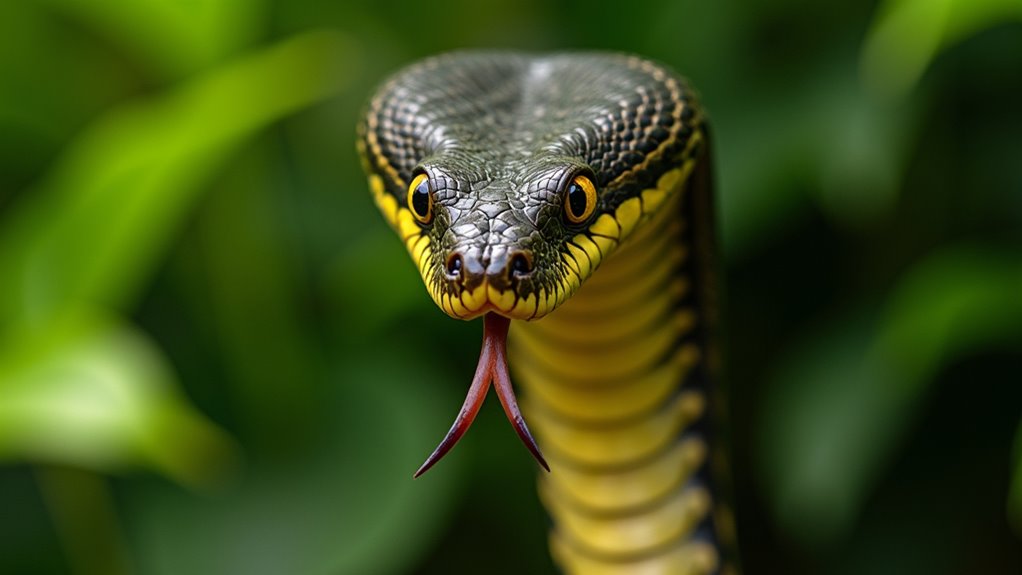
In Vietnam's lush landscapes lurk deadly predators from venomous cobras to transparent jellyfish that could end your journey instantly.
Vietnam’s deadliest wildlife includes the king cobra with neurotoxins powerful enough to kill elephants, transparent box jellyfish containing lethal venom, and the camouflaged stonefish with fatal spines. You’ll also need to watch for Malayan sun bears, aggressive wild boars, giant hornets with painful stings, and the blue-ringed octopus in coastal waters. When exploring Vietnam’s diverse ecosystems, knowing how to identify these creatures and proper safety precautions could save your life.
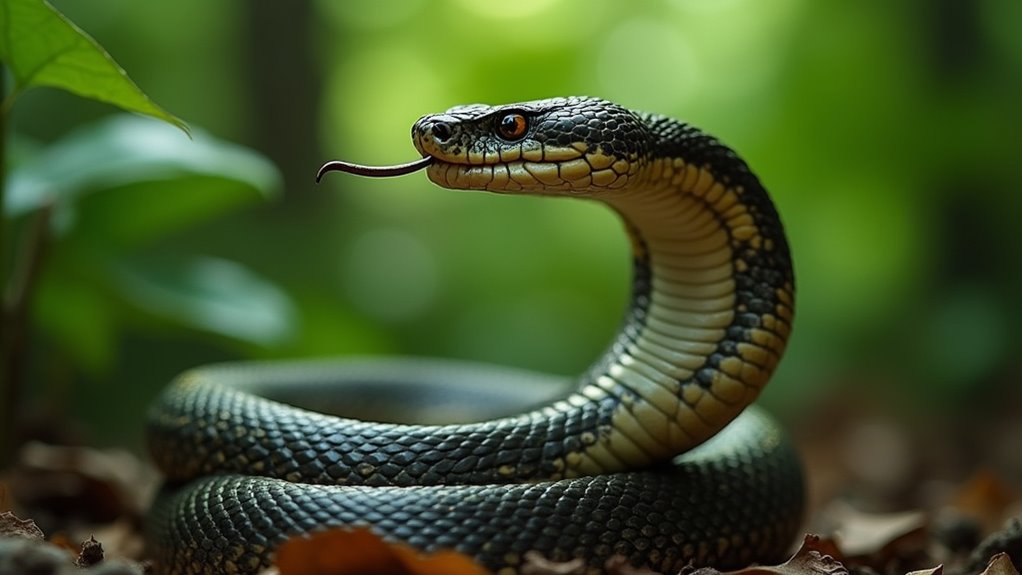
Among the many dangerous creatures inhabiting Vietnam, the King Cobra is prominent as the country’s longest venomous serpent. This impressive predator averages 3-3.6 meters in length and is widespread across Vietnam’s lowland and mountainous regions.
You’ll recognize the King Cobra by its olive-green to black coloration with pale yellow crossbands and its distinctive hood display when threatened. Its venom contains potent alpha-neurotoxins that primarily attack the nervous system. It’s primarily diurnal, hunting other snakes and lizards while spending about a quarter of its time in trees.
Though its venom can deliver a lethal dose sufficient to kill an elephant, fatalities are relatively rare due to the snake’s tendency to deliver defensive bites with minimal envenomation. Despite its fearsome reputation, the King Cobra is just one of nine venomous species that inhabit Vietnam’s diverse ecosystems.
Despite its capability to kill an elephant, the King Cobra’s defensive nature often prevents fatal human encounters.
If you’re exploring forests near waterways or agricultural areas, remain vigilant—these apex predators prefer humid environments like mangroves and bamboo thickets.
Vietnam’s coastal waters harbor one of the ocean’s most lethal inhabitants—the box jellyfish. Nearly transparent and armed with tentacles up to 3 meters long, these deadly creatures are almost impossible to spot while swimming.
The box jellyfish’s venom is extraordinarily potent—a single animal carries enough toxin to kill 60 adults. In Vietnam, the highly dangerous species Chironex fleckeri is present, recognizable by its transparent bell that from certain angles resembles a human head or skull. If you’re planning beach activities in Vietnam, particularly in warm waters of the Indian and Pacific Oceans, be extra vigilant during wet seasons when they’re more active.
Should you encounter one, the results can be catastrophic. Stings cause excruciating pain and can be fatal without immediate medical attention. Always check local warnings before swimming, and know basic first aid for stings.
If you’re trying to decide between Asian destinations, note that coastal hazards vary significantly between popular locations like Tokyo and Seoul.
These silent predators serve as indicators of changing marine ecosystems, particularly in areas with rising water salinity.
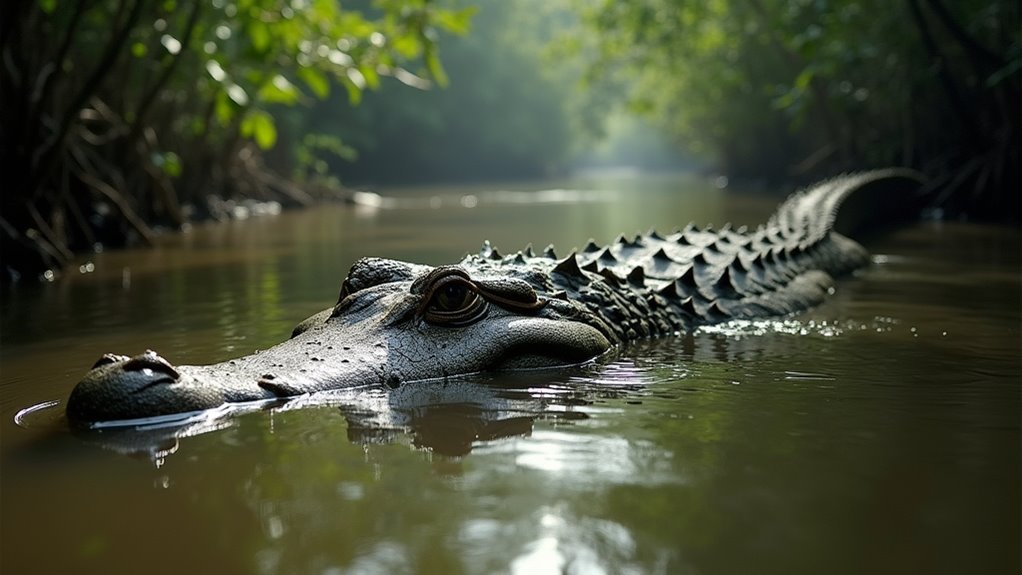
While box jellyfish patrol Vietnam’s coastal waters, the Mekong Delta once housed a far more formidable predator. Saltwater crocodiles, reaching over 20 feet in length, ruled Vietnam’s waterways as apex predators until their extinction in the wild around 2000.
These massive reptiles could surge through water at 10mph, ambushing prey along riverbanks. They thrived in brackish Mekong estuaries and mangrove swamps, particularly in areas like Rung Sat Swamp (now Can Gio Biosphere). Historical records show they once had a much broader range, extending from southeastern China to the islands of Palau.
Apex predators of Vietnam’s waterways, saltwater crocodiles lurked silently in mangrove swamps, ready to explode into lethal action.
Despite their ecological importance in regulating fish populations, saltwater crocodiles faced mounting threats from habitat destruction, dam construction, and hunting for their valuable skins. The region’s transformation into dangerous places for these reptiles mirrors similar wildlife declines across Asia.
Today, only Siamese crocodiles remain in Vietnam, with pure saltwater specimens preserved only in captivity at Can Gio.
Known for its lethal venom and distinctive markings, the Russell’s viper ranks among Southeast Asia’s most dangerous snakes. You’ll find this highly adaptable predator in Vietnam’s grasslands, agricultural areas, and scrublands, often near human settlements where rodents thrive.
Though primarily nocturnal, these vipers sometimes bask during daylight hours in cooler weather.
When threatened, they’ll form tight S-shaped coils, hiss loudly, and strike with remarkable force, potentially hanging onto victims for several seconds.
Their advanced venom delivery system makes them particularly dangerous, contributing markedly to snakebite fatalities across the region. Envenomation symptoms typically include immediate pain and swelling at the bite site, followed by bleeding from gums and other concerning symptoms within minutes.
Despite this fearsome reputation, Russell’s vipers play a vital ecological role by controlling rodent populations that damage crops.
If you’re exploring rural Vietnam, maintain vigilance in tall grass and agricultural fields, especially around Hanoi where urban expansion has pushed these snakes closer to populated areas.
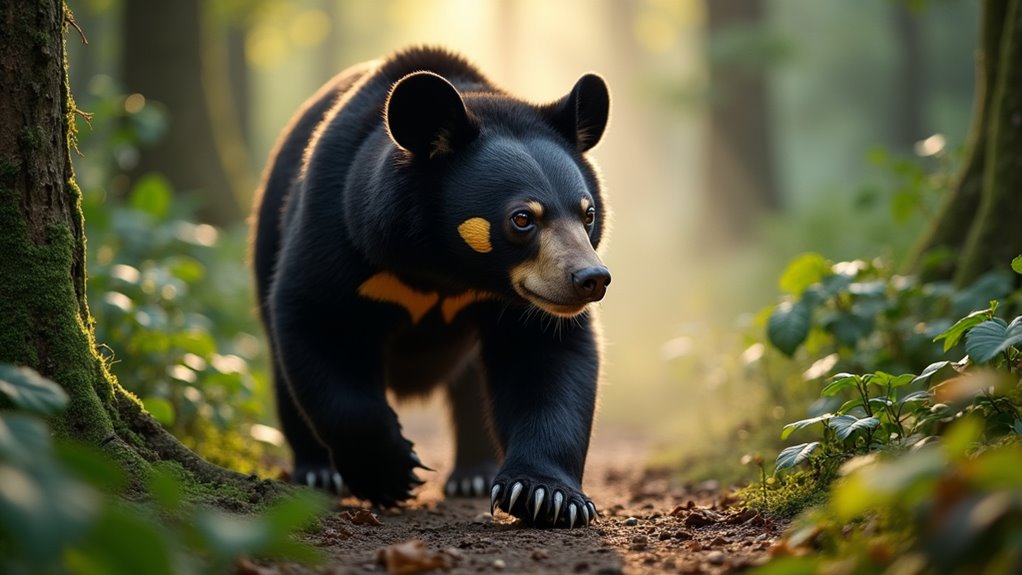
The smallest bear species in the world, the Malayan sun bear inhabits Vietnam’s tropical rainforests with a distinctive golden chest patch resembling a rising sun. You’ll find these expert climbers in evergreen and montane forests, though habitat loss increasingly drives them into plantations and farmlands.
While typically shy and solitary, don’t underestimate these bears if confronted. When provoked or surprised, especially mothers protecting cubs, they’ll fiercely defend themselves with sharp claws and powerful jaws. These bears have suffered a population decline rate of over 30% in just three decades.
Their omnivorous diet includes insects, honey, fruits, and small mammals. Despite their small stature, they’re classified as “Vulnerable” due to poaching for traditional medicine and the pet trade.
Human-bear conflicts have risen as their habitat shrinks, making forest preservation vital for avoiding dangerous encounters. Similar to other deadly wildlife in Southeast Asia, they’re considered among the most dangerous animals in neighboring Cambodia as well.
Vietnam’s forests harbor the intimidating Asian giant hornet, a formidable insect that’s earned its “murder hornet” nickname through sheer size and potent venom. These giants can reach 2 inches in length with a 3-inch wingspan, making them the world’s largest hornet species. This distinctive species has a large yellow-orange head with prominent teardrop-shaped eyes that make it easily identifiable.
If you encounter these orange-yellow predators during your Vietnam travels, be extremely cautious:
While both Southeast Asian destinations offer stunning natural beauty, Vietnam’s wilderness areas require greater awareness of potentially dangerous wildlife than Bali. Always maintain a safe distance and seek immediate medical attention if stung.
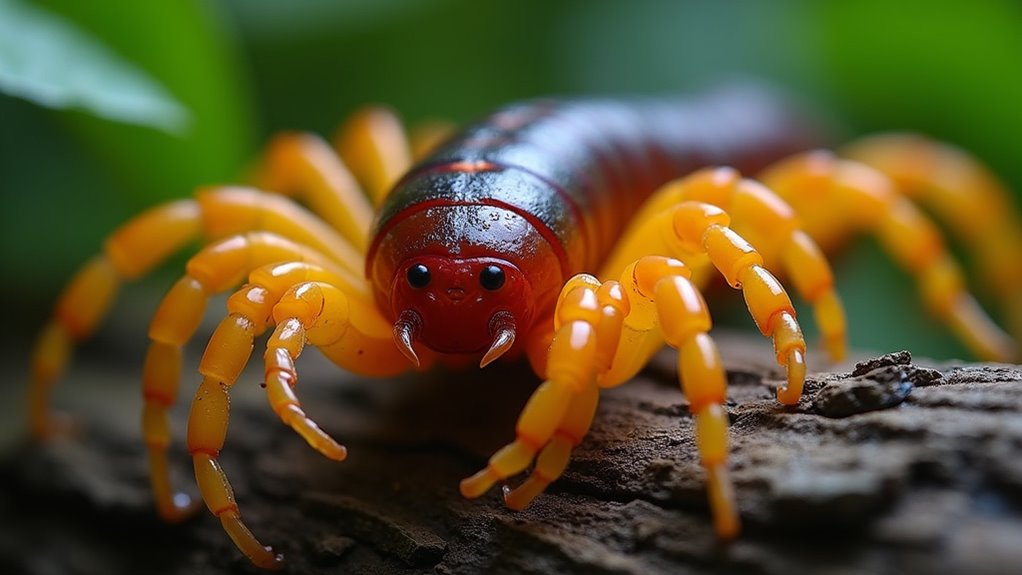
These reddish-brown hunters with yellow legs are aggressive predators that won’t hesitate to attack. They inject venom through modified front legs called forcipules, causing intense pain and swelling that can last for days.
Though rarely fatal (only one recorded human death), an encounter is something you’ll never forget.
You’ll find these centipedes in moist environments under rocks and logs. Vietnam’s tropical climate provides ideal breeding conditions for these aggressive arthropods. Despite poor eyesight, they’re remarkably fast and can live up to 10 years. These creatures can grow to 20cm in length, though exceptionally large specimens have been documented.
They’re popular in the exotic pet trade, but you’re better off admiring them from a distance.
Among the many marine hazards of Vietnam’s waters, stonefish stand out as particularly treacherous predators. These well-camouflaged fish inhabit the shallow coastal regions across Vietnam’s extensive shoreline, perfectly mimicking rocks or coral with their mottled brown and gray bodies. While similar dangerous species can be found in The Philippines, Vietnam’s coastal waters require particular vigilance when swimming or wading.
The venom of Synanceia verrucosa can be fatal with as little as 18mg of toxin entering the human body.
If you’re exploring Vietnam’s beautiful coastal waters, always wear protective footwear and scan carefully before taking each step.
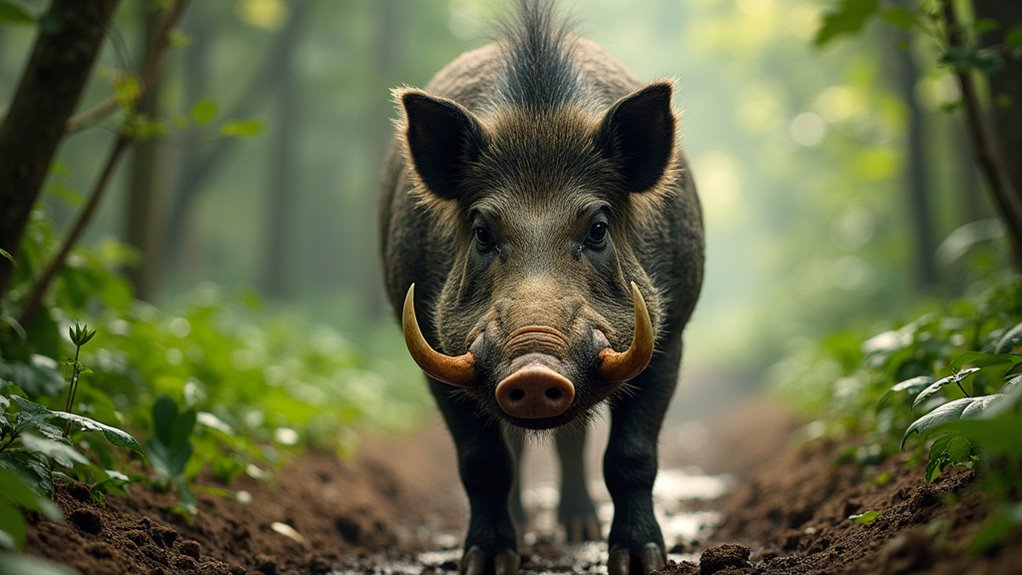
Lurking within Vietnam’s lush forests and rural landscapes, wild boars represent one of the countryside’s most formidable yet often overlooked threats. These powerful mammals can reach 1.35 meters in length and weigh over 100 kilograms, wielding sharp tusks used for both defense and attack.
When threatened, wild boars form defensive circles with their young protected in the center. Adult males are particularly aggressive, sometimes attacking animals much larger than themselves. Vietnamese wild boars belong to the Eastern group of subspecies, including the Chinese long-maned pig with its distinctive brindled coat and impressive mane. Most fatal human encounters occur outside hunting situations or when the animals feel provoked.
Despite conservation concerns due to habitat loss, Vietnam has a strong demand for wild boar meat, driving continued poaching. If you’re exploring rural areas, maintain a safe distance from these creatures – their omnivorous diet and territorial nature make them unpredictable adversaries. While Vietnam offers extraordinary outdoor adventures across its diverse landscapes, encounters with wildlife like wild boars require appropriate caution and respect for their territory.
Measuring just 12-20 centimeters in arm span, the blue-ringed octopus delivers a deadly punch that belies its diminutive size.
Found in Vietnam’s tropical waters, this creature carries tetrodotoxin (TTX) that’s 1,000 times more potent than cyanide.
When threatened, its dull camouflage transforms, revealing vibrant blue rings as a warning display. These striking patterns are created by specialized iridophores and chromatophores working together to produce their distinctive coloration.
Unlike the party atmosphere found in Japan’s vibrant cities, encountering this creature brings deadly danger rather than excitement.
If you’re exploring Vietnam’s reefs, be aware of these critical facts:
Despite their deadly nature, blue-ringed octopuses aren’t aggressive unless provoked, making awareness your best protection.

The spotted-scaled viper slithers through Northern Vietnam’s forests as one of the region’s most dangerous serpents. You’ll find this venomous pit viper in the hilly forests of Quan Son District, often lurking near streams and in tree hollows.
Don’t underestimate its potency—its venom targets your blood circulation, causing serious coagulation issues with hemorrhagic and necrotic effects. Each bite delivers more venom than several other dangerous snake species in the region.
These nocturnal hunters primarily feed on small mammals, effectively controlling rodent populations in forest ecosystems. Adult vipers particularly target rats as prey, while juveniles tend to hunt frogs. Unlike many Asian cultures where snake meat is considered a delicacy, these vipers are typically avoided due to their dangerous venom.
Females lay eggs in tree hollows and guard them until hatching.
While specific antivenom information is limited, forest workers face the highest bite risk. Their recently sequenced genome (2023) may improve treatment options.
Vietnam’s wildlife demands respect, not fear. You’ll encounter these powerful creatures from the coiled king cobra to the deceptively calm waters hiding box jellyfish. When trekking through forests where sun bears roam or wading in shallow waters where stonefish lurk, proper preparation is your lifeline. Remember, you’re a visitor in their territory. Research, remain vigilant, and you’ll safely experience Vietnam’s breathtaking natural diversity without becoming part of the food chain.